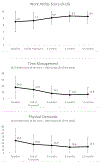Results from a prospective longitudinal survey of employment and work outcomes in newly diagnosed cancer patients during and after curative-intent chemotherapy: A Wisconsin Oncology Network study
- PMID: 33231882
- PMCID: PMC7945680
- DOI: 10.1002/cncr.33311
Results from a prospective longitudinal survey of employment and work outcomes in newly diagnosed cancer patients during and after curative-intent chemotherapy: A Wisconsin Oncology Network study
Abstract
Background: Postcancer work limitations may affect a substantial proportion of patients and contribute to the "financial toxicity" of cancer treatment. The degree and nature of work limitations and employment outcomes are poorly understood for cancer patients, particularly in the immediate period of transition after active treatment. We prospectively examined employment, work ability, and work limitations during and after treatment.
Methods: A total of 120 patients receiving curative therapy who were employed prior to their cancer diagnosis and who intended to work during or after end of treatment (EOT) completed surveys at baseline (pretreatment), EOT, and 3, 6, and 12 months after EOT. Surveys included measures of employment, work ability, and work limitations. Descriptive statistics (frequencies, percentages, means with standard deviations) were calculated.
Results: A total of 111 participants completed the baseline survey. On average, participants were 48 years of age and were mostly white (95%) and female (82%) with a diagnosis of breast cancer (69%). Full-time employment decreased during therapy (from 88% to 50%) and returned to near prediagnosis levels by 12-month follow-up (78%). Work-related productivity loss due to health was high during treatment.
Conclusions: This study is the first to report the effects of curative intent cancer therapy on employment, work ability, and work limitations both during and after treatment. Perceived work ability was generally high overall 12 months after EOT, although a minority reported persistent difficulty. A prospective analysis of factors (eg, job type, education, symptoms) most associated with work limitations is underway to assist in identifying at-risk patients.
Keywords: cancer survivorship; cancer work limitations; return to work; working during cancer treatment.
© 2020 American Cancer Society.
Conflict of interest statement
Figures


Comment in
-
Reply to The effects of curative-intent cancer therapy on employment, work ability, and work limitations.Cancer. 2021 Aug 15;127(16):3033-3034. doi: 10.1002/cncr.33566. Epub 2021 Jun 18. Cancer. 2021. PMID: 34143434 No abstract available.
-
The effects of curative-intent cancer therapy on employment, work ability, and work limitations.Cancer. 2021 Aug 15;127(16):3031-3032. doi: 10.1002/cncr.33569. Epub 2021 Jun 18. Cancer. 2021. PMID: 34143435 No abstract available.
Similar articles
-
Long-term employment status and quality of life after cancer: A longitudinal prospective cohort study from diagnosis up to and including 5 years post diagnosis.Work. 2020;66(4):901-907. doi: 10.3233/WOR-203234. Work. 2020. PMID: 32925145 Free PMC article. Clinical Trial.
-
Relationship between self-reported cognitive function and work-related outcomes in breast cancer survivors.J Cancer Surviv. 2018 Apr;12(2):246-255. doi: 10.1007/s11764-017-0664-6. Epub 2017 Dec 8. J Cancer Surviv. 2018. PMID: 29222703
-
"Cancer Put My Life on Hold": Work-Related Challenges Among Middle-aged Adults 12 Months After a Diagnosis of Colorectal Cancer.Cancer Nurs. 2017 Mar/Apr;40(2):160-167. doi: 10.1097/NCC.0000000000000359. Cancer Nurs. 2017. PMID: 26925997
-
Return to Work and Employment Situation of Young Adult Cancer Survivors: Results from the Adolescent and Young Adult-Leipzig Study.J Adolesc Young Adult Oncol. 2021 Apr;10(2):226-233. doi: 10.1089/jayao.2020.0055. Epub 2020 Aug 3. J Adolesc Young Adult Oncol. 2021. PMID: 32746763
-
[A group cognitive behavioral intervention for people registered in supported employment programs: CBT-SE].Encephale. 2014 Jun;40 Suppl 2:S81-90. doi: 10.1016/j.encep.2014.04.005. Epub 2014 Jun 16. Encephale. 2014. PMID: 24948482 Review. French.
Cited by
-
Unmet needs and problems related to employment and working as reported by survivors with metastatic breast cancer.Support Care Cancer. 2022 May;30(5):4291-4301. doi: 10.1007/s00520-021-06755-z. Epub 2022 Jan 28. Support Care Cancer. 2022. PMID: 35088147 Free PMC article.
-
The dynamic relationship between cancer and employment-related financial toxicity: an in-depth qualitative study of 21 Australian cancer survivor experiences and preferences for support.Support Care Cancer. 2022 Apr;30(4):3093-3103. doi: 10.1007/s00520-021-06707-7. Epub 2021 Dec 1. Support Care Cancer. 2022. PMID: 34850273
-
Racial and Ethnic Differences in the Financial Consequences of Cancer-Related Employment Disruption.Front Oncol. 2021 Jul 30;11:690454. doi: 10.3389/fonc.2021.690454. eCollection 2021. Front Oncol. 2021. PMID: 34395255 Free PMC article.
-
Survivorship, Version 1.2021.J Natl Compr Canc Netw. 2021 Jun 30;19(6):676-685. doi: 10.6004/jnccn.2021.0028. J Natl Compr Canc Netw. 2021. PMID: 34214969 Free PMC article.
-
Prognostic factors for return to work in breast cancer survivors.Cochrane Database Syst Rev. 2025 May 7;5(5):CD015124. doi: 10.1002/14651858.CD015124.pub2. Cochrane Database Syst Rev. 2025. PMID: 40331515 Review.
References
-
- Zafar SY and Abernethy AP, Financial toxicity, Part II: how can we help with the burden of treatment-related costs? Oncology (Williston Park), 2013. 27(4): p. 253–4, 256. - PubMed
-
- Board., P.A.T.E., Financial Toxicity and Cancer Treatment (PDQ®): Health Professional Version. PDQ Cancer Information Summaries [Internet]. Bethesda (MD): National Cancer Institute (US); Available from: https://www.ncbi.nlm.nih.gov/books/NBK384502, 2019. September 18.
Publication types
MeSH terms
Grants and funding
LinkOut - more resources
Full Text Sources
Medical

